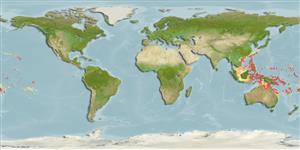Classification / Names
Common names from other countries
Main reference
Size / Weight / Age
Max length : 3.0 cm SL male/unsexed; (Ref. 48637); max. reported age: 0 years (Ref. 87294)
Environment
Marine; reef-associated; depth range 1 - 90 m (Ref. 86942), usually 4 - 35 m (Ref. 90102)
Climate / Range
Tropical, preferred ?
Distribution
Short description
Dorsal
spines
(total): 7;
Dorsal
soft rays
(total): 9-10;
Anal
spines: 1;
Anal
soft rays: 8 - 10. Distinguished by having the following characters: a deep concave, ‘U’-shaped interorbital trench; the bony interorbital about half pupil-diameter in width; with a slight groove posterodorsal to the eye; without median predorsal scales, sides of nape covered with small scales reaching to or near to the eyes; cheek and operculum without scales; base of pectoral-fin with oval, moderate-sized scales; prepelvic area with 5-6 rows of cycloid scales, isthmus naked anteriorly, with one slightly enlarged scale on the membrane between the bases of the pelvic fins; central 6-13 pectoral rays branched, uppermost and lowermost rays unbranched; fifth pelvic-fin ray branched once dichotomously and about 60-75% length of the fourth; all other rays usually with one sequential branch, basal membrane connecting the two pelvic fins only at the base; second dorsal spine longest, usually filamentous, extending at most to midway along the base of the second dorsal fin in Australian material; D2 usually I,10; A usually I, 9; nape crest fleshy from the first dorsal origin to above the operculum; when alive, head and body red, preserved yellow, the head with a thin vertical grey (bluish grey in life) bar from the anteroventral margin of the eye to the middle of the jaws and a second bar extending more-or-less vertically downward onto cheek from about the middle of the eye (often persisting in preserved material as faint grey bars); orbit rimmed with a thin band of melanophores, more distinct dorsally but faded in preserved material (Ref. 100726).
IUCN Red List Status (Ref. 115185)
Threat to humans
Harmless
Human uses
More information
Common namesSynonymsMetabolismPredatorsEcotoxicologyReproductionMaturitySpawningFecundityEggsEgg development
ReferencesAquacultureAquaculture profileStrainsGeneticsAllele frequenciesHeritabilityDiseasesProcessingMass conversion
Tools
Special reports
Download XML
Internet sources
Estimates of some properties based on models
Phylogenetic diversity index
PD50 = 0.5000 many relatives (e.g. carps) 0.5 - 2.0 few relatives (e.g. lungfishes)
Trophic Level
0
Resilience
High, minimum population doubling time less than 15 months (Preliminary K or Fecundity.)
Vulnerability
Low vulnerability (10 of 100)
Price category
